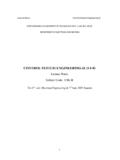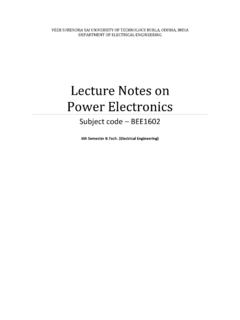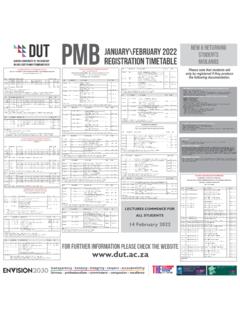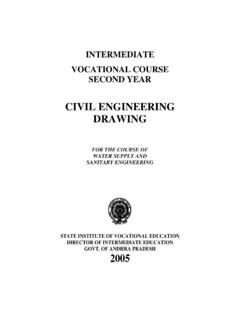Transcription of on CIVIL ENGINEERING MATERIALS & CONSTRUCTION …
1 LECTURE NOTE on CIVIL ENGINEERING MATERIALS & CONSTRUCTION course code : BCE 203 SYLLABUS Module Number Chapter Number Title Lecture hours (3- 1- 0) 1 1 Brick 3 2 Cement 4 3 Concrete 3 Total 10 2 4 Arches 3 5 Cavity Wall 2 6 Stairs 3 Total 8 3 7 Fire Resistive CONSTRUCTION 2 8 Plastering 2 9 Damp prevention 2 Total 6 4 10 Types of doors and windows 3 11 Painting and decoration 2 12 Glazing 2 13 Repair of Building 2 14 Stone 1 15 Timber 4 16 Foundation 2 Total 16 Total lecture hours 40 Text books 1. A Text book of Building CONSTRUCTION , Arora and Bindra, Dhanpat Rai & Sons. Reference books 1 A Text Book of Building MATERIALS , Kulkarrni 2 Building MATERIALS , P.
2 C. Varghese, PHI, Pvt. Ltd. 3 Building CONSTRUCTION , P. C. Varghese, PHI, Pvt. Ltd. 1. BRICK Constituents of good brick earth: Bricks are the most commonly used CONSTRUCTION material . Bricks are prepared by moulding clay in rectangular blocks of uniform size and then drying and burning these blocks. In order to get a good quality brick, the brick earth should contain the following constituents. o Silica o Alumina o Lime o Iron oxide o Magnesia Silica o Brick earth should contain about 50 to % of silica. o It is responsible for preventing cracking, shrinking and warping of raw bricks. o It also affects the durability of bricks.
3 O If present in excess, then it destroys the cohesion between particles and the brick becomes brittle. Alumina o Good brick earth should contain about 20% to 30% of alumina. o It is responsible for plasticity characteristic of earth, which is important in moulding operation. o If present in excess, then the raw brick shrink and warp during drying. Lime o The percentage of lime should be in the range of 5% to 10% in a good brick earth. o It prevents shrinkage of bricks on drying. o It causes silica in clay to melt on burning and thus helps to bind it. o Excess of lime causes the brick to melt and brick looses its shape.
4 Iron oxide o A good brick earth should contain about 5% to 7% of iron oxide. o It gives red colour to the bricks. o It improves impermeability and durability. o It gives strength and hardness. o If present in excess, then the colour of brick becomes dark blue or blakish. o If the quantity of iron oxide is comparatively less, the brick becomes yellowish in colour. 1* Under revisionMagnesia o Good brick earth should contain less a small quantity of magnesia about1%) o Magnesium in brick earth imparts yellow tint to the brick. o It is responsible for reducing shrinkage o Excess of magnesia leads to the decay of bricks.
5 Harmful Ingredients in Brick: Below mentioned are some of the ingredients which are undesired in brick earth. Lime o A small quantity of lime is required in brick earth. But if present in excess, it causes the brick to melt and hence brick looses its shape. o If lime is present in the form of lumps, then it is converted into quick lime after burning. This quick lime slakes and expands in presence of moisture, causing splitting of bricks into pieces. Iron pyrites o The presence of iron pyrites in brick earth causes the brick to get crystallized and disintegrated during burning, because of the oxidation of the iron pyrits.
6 O Pyrites discolourise the bricks. Alkalis o These are exist in the brick earth in the form of soda and potash. It acts as a flux in the kiln during burning and it causes bricks to fuse, twist and warp. Because of this, bricks are melted and they loose their shape. o The alkalis remaining in bricks will absorb moisture from the atmosphere, when bricks are used in masonry. With the passage of time, the moisture gets evaporated leaving grey or white deposits on the wall surface (known asefflorescence). This white patch affects the appearance of the building structure.
7 Pebbles o Pebbles in brick earth create problem during mixing operation of earth. It prevents uniform and through mixing of clay, which results in weak and porous bricks o Bricks containing pebbles will not break into shapes as per requirements. Vegetation and Organic Matter o The presence of vegetation and organic matter in brick earth assists in burning. But if such matter is not completely burnt, the bricks become porous. This is due to the fact that the gasses will be evolved during the burning of the carbonaceous matter and it will result in the formation of small pores. 2* Under revision Efflorescence in BrickStone in Brick Manufacturing of bricks In the process of manufacturing bricks, the following distinct operations are involved.
8 Preparation of clay Moulding Drying Burning Each of the above operation of the manufacturing bricks will now be studied at length. Preparation of clay The clay for brick is prepared in the following order. Unsoiling Digging Cleaning Weathering Blending Tempering Unsoiling: The top layer of the soil, about 200mm in depth, is taken out and thrown away. The clay in top soil is full of impurities and hence it is to be rejected for the purpose of preparing bricks. Digging: The clay is then dug out from the ground. It is spread on the levelled ground, just a little deeper than the general level.
9 The height of heaps of clay is about 600mm to 1200mm. Cleaning: The clay as obtained in the process of digging should be cleaned of stones, pebbles, vegetable matters. If these particles are in excess, the clay is to be washed and screened. Such a process naturally will prove to be troublesome and expensive. 3* Under revisionWeathering: The clay is then exposed to atmosphere for softening and mellowing. The period varies from few weeks to full season. Blending: The clay is made loose and any ingredient to be added to it , is spread out at its top. The blending indicates intimate or harmonious mixing.
10 It is carried out by taking a small amount of clay every time and turning it up and down in vertical direction. The blending makes clay fit for the next stage of tempering. Tempering: In the process of tempering, the clay is brought to a proper degree of hardness and it is made fit for the next operation of moulding .Kneaded or pressed under the feet of man or cattle .The tempering should be done exhaustively to obtain homogeneous mass of clay of uniform manufacturing good bricks on a large scale, tempering is done in pug typical pug mill capable of tempering sufficient earth for a daily output of about 15000 to20000 bricks.














